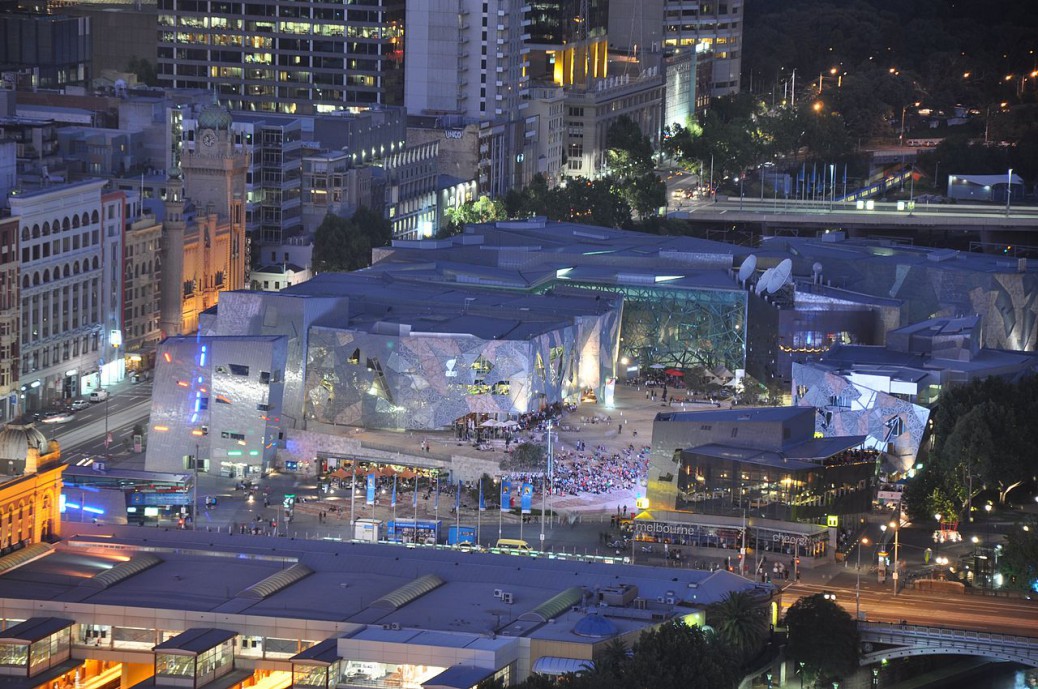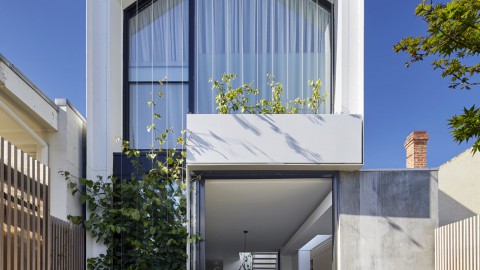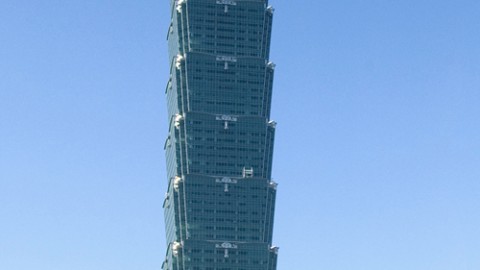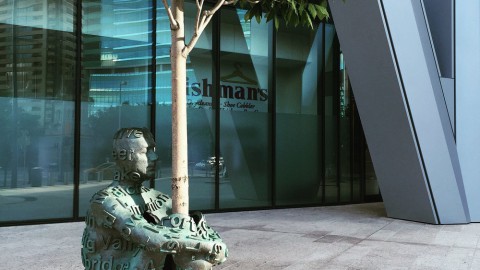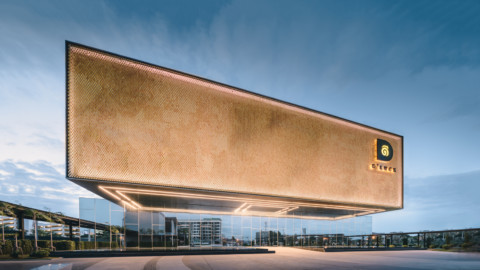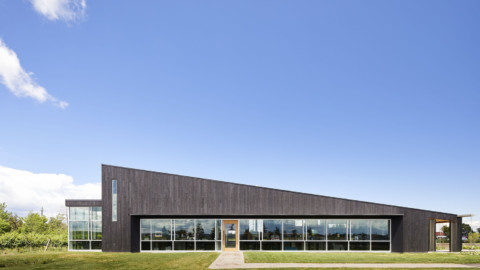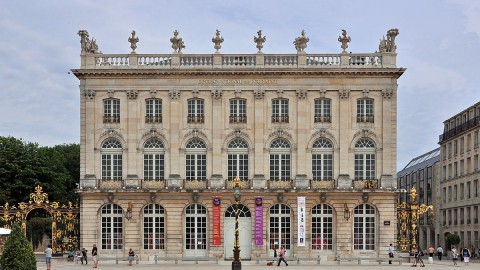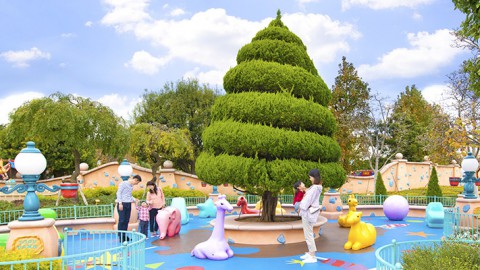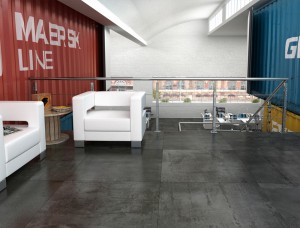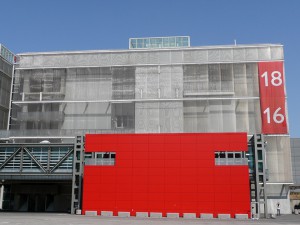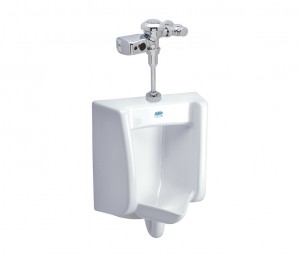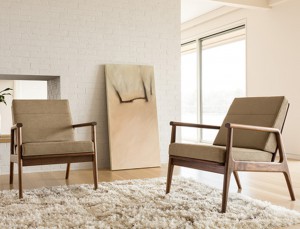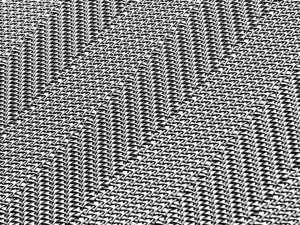Federation Square 聯邦廣場
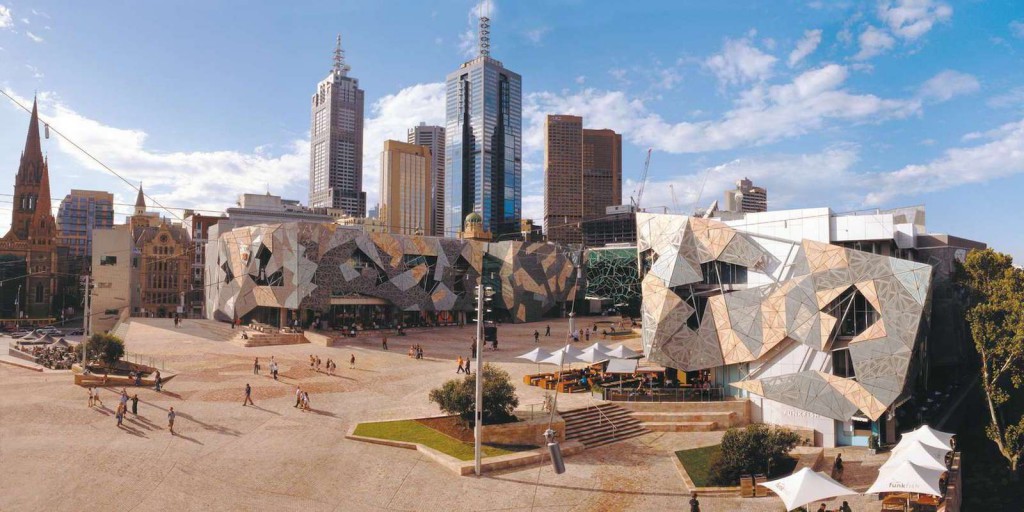
Federation Square is a venue for arts, culture and public events on the edge of the Melbourne central business district. It covers an area of 3.2 ha (7.9 acres) at the intersection of Flinders and Swanston Streets built above busy railway lines and across the road from Flinders Street station. It incorporates major cultural institutions such as the Ian Potter Centre and ACMI and Koorie Heritage Trust as well as cafes and bars in a series of buildings centred around a large paved square, and a glass walled atrium. The corner is occupied by a glass walled pavilion that provides access to the underground Melbourne Visitor Centre.
聯邦廣場是墨爾本中央商務區邊緣的藝術,文化和公共活動場所。 它佔地面積3.2公頃(7.9英畝),位於弗林德斯和斯旺斯頓街道的交匯處,這些街道位於繁忙的鐵路線上,位於弗林德斯街車站的馬路對面。 它包括伊恩波特中心和ACMI和Koorie Heritage Trust等主要文化機構,以及圍繞大型鋪砌廣場和玻璃牆中庭的一系列建築中的咖啡館和酒吧。 拐角處有一個玻璃幕牆亭,可通往墨爾本地下游客中心。
Type:Public space
Location:Melbourne, Australia
Coordinates:37.817798°S 144.968714°ECoordinates: 37.817798°S 144.968714°E
Area:3.2 ha (7.9 acres)
Created:26 October 2002
Designer:Lab Architecture Studio
Bates Smart
Operated by: Fed Square Pty Ltd (State Trustees Ltd for State of Victoria)
Visitors:8.5 million
Open:All year
Status:it is the center of melbourne and most visited place in melbourne. most of the cultural and festive programmes are held there. specially christmas.
Public transit access: Flinders Street station
類型:公共空間
地點:澳大利亞墨爾本
坐標:37.817798°S 144.968714°ECoordinates:37.817798°S 144.968714°E
面積:3.2公頃(7.9英畝)
創建時間:2002年10月26日
設計師:Lab Architecture Studio
貝茨智能
運營:Fed Square Pty Ltd(維多利亞州立大學有限公司)
參觀者:850萬
開放:全年
現狀:它是墨爾本的中心,也是墨爾本最受歡迎的地方。 大多數文化和節日節目都在那裡舉行。 特別聖誕節。
公共交通通道:弗林德斯街站
Background
Melbourne’s central city grid was designed without a central public square, long seen as a missing element. From the 1920s there were proposals to roof the railway yards on the southeast corner of Flinders and Swanston Streets for a public square, with more detailed proposals prepared in the 1950s and 1960s. In the 1960s, the Melbourne City Council decided that the best place for the City Square was the corner of Swanston and Collins Streets, opposite the town hall. The first temporary square opened in 1968, and a permanent version opened in 1981. It was however not considered a great success, and was redeveloped in the 1990s as a smaller simpler space in front of a new large hotel.
Meanwhile, the railway yards had been partly roofed by the construction of the Princes Gate Towers, known as the Gas & Fuel Buildings after their major tenant, the Gas and Fuel Corporation over the old Princes Bridge station, in the 1960s. This included a plaza on the corner, which was elevated above the street and little used. Between that and Batman Avenue, which ran along the north bank of the Yarra River, were the extensive Jolimont Railway Yards, and the through train lines running into Flinders Street station under Swanston Street.
背景
墨爾本的中心城市網格設計沒有中央公共廣場,長期以來被視為缺失元素。從20世紀20年代開始,有人建議將弗林德斯和斯旺斯頓街道東南角的鐵路碼頭放在公共廣場上,並在20世紀50年代和60年代製定更詳細的建議。在20世紀60年代,墨爾本市議會決定城市廣場的最佳位置是斯旺斯頓街和柯林斯街的角落,在市政廳對面。第一個臨時廣場於1968年開放,永久版本於1981年開放。但它並未被認為是一個巨大的成功,並在20世紀90年代重新開發為一個較小的簡單空間,在一個新的大型酒店前。
與此同時,在20世紀60年代,在他們的主要租戶 – 天然氣和燃料公司在舊王子橋站之後建造的王子門塔(Princes Gate Towers)被稱為天然氣和燃料建築物,部分地舖設了鐵路站場。這包括一個位於街角上方的廣場,很少使用。在那條和沿著亞拉河北岸延伸的蝙蝠俠大道之間,有廣闊的Jolimont鐵路碼頭,以及通往斯旺斯頓街下的弗林德斯街站的直達列車線。
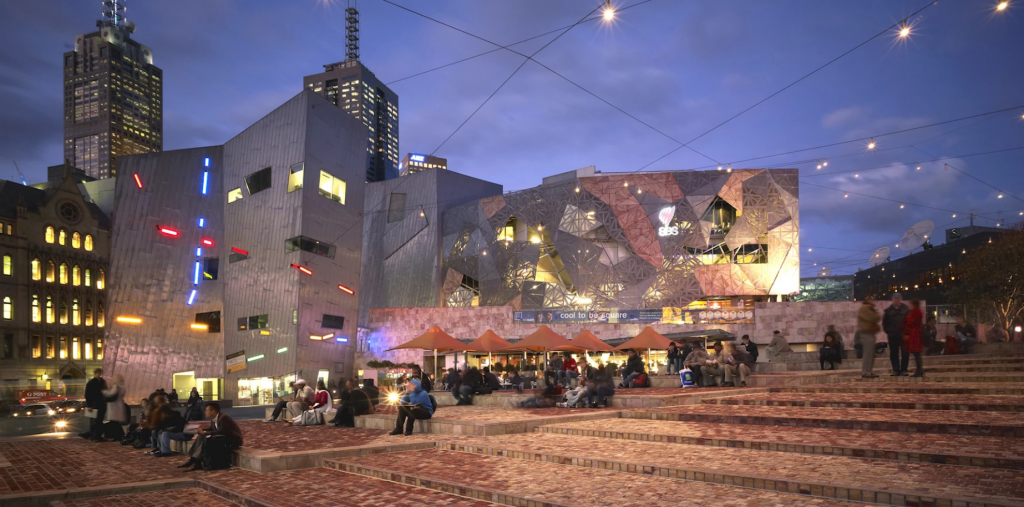
Design competition and controversy
In 1996 the then Premier Jeff Kennett announced the much-hated Gas & Fuel Buildings would be demolished, and the railyards roofed and a complex including arts facilities and a large public space would be built. It was to be named Federation Square, and opened in time to celebrate the centenary of Australia’s Federation in 2001, and would include performing arts facilities, a gallery, a cinemedia centre, the public space, a glazed wintergarden, and ancillary cafe and retail spaces. An architectural design competition was announced that received 177 entries from around the world. Five designs were shortlisted, which included entries from high-profile Melbourne architects Denton Corker Marshall and Ashton Raggatt McDougall, and lesser known Sydney architect Chris Elliott, and London based Jenny Lowe/Adrian Hawker. The winner announced in July 1997, was a consortium of Lab Architecture Studio directed by Donald Bates and Peter Davidson from London, Karres en Brands Landscape Architects directed by Sylvia Karres and Bart Brands, who joined with local architects Bates Smart for the second stage.
The design, originally costed at between $110 and $128 million, was complex and irregular, with gently angled ‘cranked’ geometries predominating in both the planning and the facade treatment of the various buildings and the wintergardens that surrounded and defined the open spaces. A series of ‘shards’ provided vertical accents, while interconnected laneways and stairways and the wintergarden would connect Flinders Street to the Yarra River. The open square was arranged as a gently sloping amphitheatre, focussed on a large viewing screen for public events, with a secondary sloped plaza area on the main corner. The design was widely supported by the design community but was less popular with the public. The design was also soon criticized when it was realised that the western freestanding ‘shard’ would block views of the south front of St Paul’s Cathedral from Princes Bridge.
The mix of occupants and tenants were soon modified, with the cinemedia centre becoming the new body known as ACMI, as well as including offices for multicultural broadcaster SBS and the gallery space becoming the Australian art wing of the National Gallery of Victoria, the performance arts space was dropped, and the number of commercial tenancies increased, with a new substantially rearranged design revealed in late 1998.
設計競賽和爭議
1996年,當時的總理傑夫·肯尼特宣布,這座備受憎恨的天然氣和燃料建築物將被拆除,並且屋頂上將建造一座包括藝術設施和大型公共空間在內的綜合建築。它被命名為聯邦廣場,並在2001年慶祝澳大利亞聯邦成立一百週年,並將包括表演藝術設施,畫廊,電影媒體中心,公共空間,玻璃冬季花園以及輔助咖啡館和零售空間。 。宣布了一項建築設計競賽,共收到來自世界各地的177個參賽作品。五個設計入圍,其中包括來自墨爾本高層建築師Denton Corker Marshall和Ashton Raggatt McDougall以及鮮為人知的悉尼建築師Chris Elliott和倫敦Jenny Lowe / Adrian Hawker的參賽作品。獲獎者於1997年7月宣布,是由倫敦的Donald Bates和Peter Davidson執導的實驗室建築工作室聯盟,由Sylvia Karres和Bart Brands執導的Karres en Brands景觀設計師,他們與當地建築師Bates Smart一起參與了第二階段。
該設計最初的成本在1.18億美元至1.28億美元之間,複雜且不規則,在各種建築的規劃和外立面處理以及圍繞和定義開放空間的冬季花園中具有輕微傾斜的“曲柄”幾何形狀。一系列“碎片”提供了垂直的重點,而相互連接的巷道和樓梯以及冬季花園將連接弗林德斯街和亞拉河。露天廣場被安排為一個平緩傾斜的圓形劇場,集中在一個大型觀景屏幕上,用於公共活動,主角上有一個次要傾斜的廣場區域。該設計得到了設計界的廣泛支持,但不太受公眾歡迎。當人們意識到西方獨立的“碎片”將阻擋王子大橋對聖保羅大教堂南面的看法時,設計也很快受到批評。
住戶和租戶的混合很快被修改,電影媒體中心成為ACMI的新機構,包括多文化廣播公司SBS的辦公室和畫廊空間成為維多利亞國家美術館的澳大利亞藝術翼,表演藝術空間被丟棄,商業租賃數量增加,1998年底出現了一個新的大幅重新設計。

Construction
After the 1999 State election, while construction was well underway, the incoming Bracks Government ordered a report by the University of Melbourne’s Professor Evan Walker into the western shard, which concluded in February 2000 that the “heritage vista” towards St Paul’s cathedral should be preserved, and the shard be no more than 8m in height.
Budgets on the project blew out significantly due to the initial cost being seriously under estimated, given the expense of covering the railyards, changes to the brief, the need to resolve construction methods for the angular design, and the long delays. Among measures taken to cut costs was concreting areas originally designed for paving.
The final cost of construction was approximately $467 million (over four times the original estimate), the main funding primarily from the state government, with $64 million from the City of Melbourne, some from the federal government, while private operators and sponsors paid for fitouts or naming rights.
The square was opened on 26 October 2002. Unlike many Australian landmarks, it was not opened by the reigning monarch, Elizabeth II, nor was she invited to its unveiling; she visited Federation Square in October 2011.
施工
在1999年的州選舉之後,在建設工作進展順利的時候,即將到來的布拉克政府下令墨爾本大學的埃文沃克教授報告西部碎片,該報告於2000年2月結束,應該保留對聖保羅大教堂的“遺產遠景” ,碎片高度不超過8米。
考慮到覆蓋鐵絲網的費用,簡要說明的變化,解決角度設計的施工方法的需要以及長時間的延誤,項目的預算大幅度減少,原因是初始成本嚴重低估。為降低成本而採取的措施包括最初為鋪路而設計的混凝土。
最終的建設成本約為4.67億美元(超過原先估計的四倍),主要資金主要來自州政府,其中6400萬美元來自墨爾本市,一些來自聯邦政府,而私營運營商和讚助商則為裝修付費或命名權。
廣場於2002年10月26日開放。與許多澳大利亞標誌性建築不同,它不是由衛冕君主伊麗莎白二世打開的,也不是她被邀請揭幕;她於2011年10月訪問了聯邦廣場。
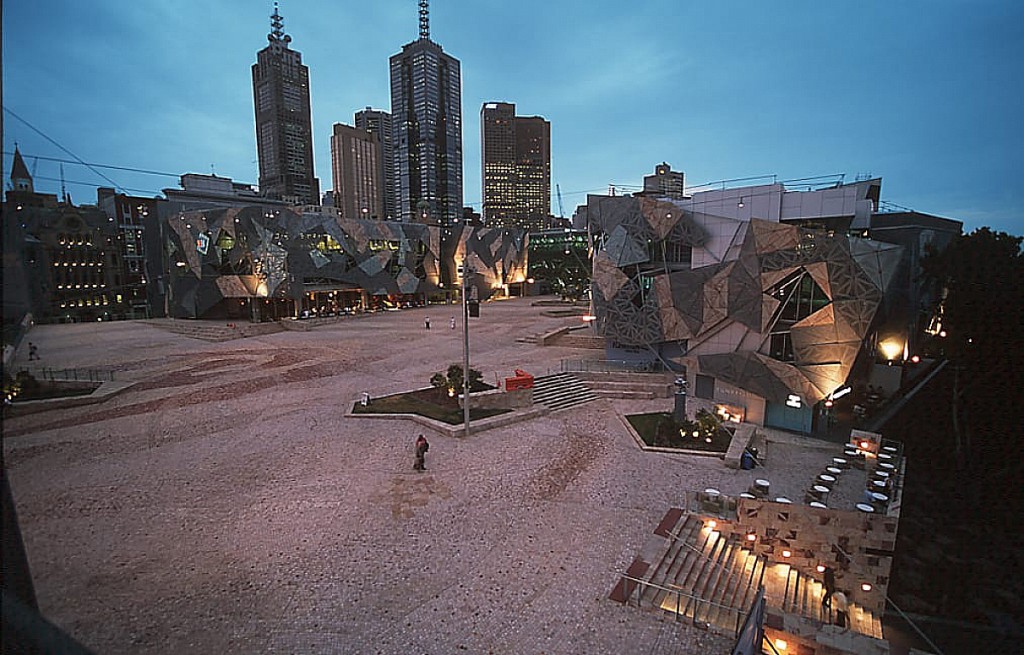
Further expansion
In 2006, Federation Wharf redeveloped the vaults under Princes Walk (a former roadway) into a large bar, with extensive outdoor areas on the Yarra riverbank, with elevator access to Federation Square.
Several proposals have been prepared for the area known as Federation Square East, the remaining area of railyards to the east. There have been proposals for office towers and, more recently, a combination of open space and a hotel, or another campus for the National Gallery of Victoria to house their contemporary art collection.
進一步擴大
2006年,聯邦碼頭將Princes Walk(一條前巷道)下的拱頂重新開發成一個大型酒吧,在亞拉河岸上設有廣闊的戶外區域,電梯可通往聯邦廣場。
已經為聯邦廣場東部地區準備了幾項建議,該地區是東部剩餘的railyards區域。 有辦公大樓的建議,最近,開放空間和酒店的組合,或維多利亞國家美術館的另一個校園,以收藏他們的當代藝術收藏品。
Location and layout
Federation Square occupies roughly a whole urban block bounded by Swanston, Flinders, and Russell Streets and the Yarra River. The open public square is directly opposite Flinders Street station and St Paul’s Cathedral. The layout of the precinct is designed to connect the historical central district of the city with the Yarra River and a new park Birrarung Marr.
位置和佈局
聯邦廣場佔據了整個城市街區,由斯旺斯頓,弗林德斯,拉塞爾街和亞拉河所圍繞。 開放的公共廣場就位於弗林德斯街火車站和聖保羅大教堂對面。 該區域的佈局旨在連接城市的歷史中心區與亞拉河和新的公園Birrarung Marr。

Design features
Square
The complex of buildings forms a rough U-shape around the main open-air square, oriented to the west. The eastern end of the square is formed by the glazed walls of The Atrium. While bluestone is used for the majority of the paving in the Atrium and St Paul’s Court, matching footpaths elsewhere in central Melbourne, the main square is paved in 470,000 ochre-coloured sandstone blocks from Western Australia and invokes images of the outback. The paving is designed as a huge urban artwork, called Nearamnew, by Paul Carter and gently rises above street level, containing a number of textual pieces inlaid in its undulating surface.
There are a small number of landscaped sections in the square and plaza which are planted with Eucalyptus trees.
Plaza and giant screen
A key part of the plaza design is its large and fixed public screen, which has been used to broadcast major sporting events such as the AFL Grand Final and still continues to do so. During the 2006 FIFA World Cup, thousands of football fans assembled to watch.
Buildings
The architecture of the square is in the deconstructivist style, with both plan and elevations designed around slightly angular, ‘cranked’ geometries, rather than tradition orthogonal grids. The built forms are mainly slightly bent north-south volumes, separated by glazed gaps, a reference to traditional Melbourne laneways, with vertical ‘shards’, attached or freestanding, containing discrete functions like the Visitor’s Centre, or lifts and stairs.
The larger built volumes are relatively simple reinforced concrete buildings with glass walls, but with a second outer skin of cladding carried on heavy steel framing, folded and stepped slightly to create angular undulating surfaces. The cladding is composed of 6 different materials, zinc, perforated zinc, glass, frosted glass, sandstone and no cladding, in a camouflage-like pattern, and created using pinwheel tiling. The ‘crossbar’ is an east-west built from that runs through the long gallery building, and is clad in perforated black steel panels.
Shards
Three shards frame the square space. The eastern and southern shards are completely clad in metallic surfaces with angular slots, very similar in design to the Jewish Museum Berlin, while the western shard is clad in glass. Adjoined to the southern shard is a hotel which features the wrap around metallic screen and glass louvers.
Laneways
There are a number of unnamed laneways in the Federation Square complex which connect it to both Flinders Street and the Yarra River via stairways. The stairways between the Western Shard and nearby buildings are also paved in larger flat rectangle sandstone blocks.
Riverfront
The riverfront areas extend south to an elevated pedestrian promenade which was once part of Batman Avenue and is lined with tall established trees of both deciduous exotic species and Australian eucalpyts. More recently, the vaults adjacent to the Princes Bridge have been converted into Federation Wharf, a series of cafes and boat berths. Some of the areas between the stairs and lanes leading to the river are landscaped with shady tree ferns.
Atrium
The “atrium” is one of the major public spaces in the precinct. It is a laneway-like space, five stories high with glazed walls and roof. The exposed metal structure and glazing patterns follow the pinwheel tiling pattern used elsewhere in the precinct’s building facades.
Labyrinth
The “labyrinth” is a passive cooling system sandwiched above the railway lines and below the middle of the square. The concrete structure consists of 1.2 km of interlocking, honeycombed walls. It covers 1600 m2. The walls have a corrugated profile to maximize their surface area, and are spaced 60 cm apart.
During summer nights, cold air is pumped in the combed space, cooling down the concrete, while heat absorbed during the day is pumped out. The following day, cold air is pumped from the labyrinth out into the atrium through floor vents. This process can keep the atrium up to 12 °C cooler than outside. This is comparable to conventional air conditioning, but using one-tenth the energy and producing one-tenth the carbon dioxide.
During winter, the process is reversed, storing warm daytime air in the Labyrinth overnight, and pumping it back into the atrium during the day.
The system can also partly cool the ACMI building when the power is not required by the atrium.
設計特點
廣場
建築群形成了一個粗糙的U形,圍繞著主要的露天廣場,朝向西方。廣場的東端由中庭的玻璃牆組成。雖然青石被用於中庭和聖保羅法院的大部分鋪設,與墨爾本市中心其他地方的人行道相匹配,但主要廣場鋪設了來自西澳大利亞的470,000個赭色砂岩塊,並調用了內陸的圖像。鋪路被設計為一個巨大的城市藝術品,被保羅卡特稱為Nearamnew,並輕輕地升到街道上方,其中包含許多鑲嵌在其起伏表面的文字作品。
廣場和廣場上有少量園景區,種植了桉樹。
廣場和巨型屏幕
廣場設計的一個關鍵部分是其大型固定公共屏幕,用於播放AFL總決賽等重大體育賽事,並且仍然繼續這樣做。在2006年FIFA世界杯期間,成千上萬的足球迷聚集在一起觀看。
房屋
廣場的建築採用解構主義風格,平面和立面都圍繞略微有角度的“曲柄”幾何設計,而不是傳統的正交網格。建築形式主要是略微彎曲的南北卷,由玻璃間隙隔開,參考傳統的墨爾本巷道,垂直“碎片”,附加或獨立,包含離散功能,如訪客中心,或升降機和樓梯。
較大的建築體積是相對簡單的鋼筋混凝土建築物,帶有玻璃牆,但第二層外層包層採用重型鋼框架,折疊並略微踩踏以形成有角度的起伏表面。包層由6種不同的材料組成,鋅,穿孔鋅,玻璃,磨砂玻璃,砂岩和無包層,採用迷彩圖案,並使用風車拼接而成。 “橫梁”是一條東西向建築,貫穿長長的廊道建築,外面是穿孔的黑色鋼板。
碎片
三個碎片構成了方形空間。東部和南部碎片完全覆蓋在金屬表面,帶有角形槽,設計與柏林猶太博物館非常相似,而西部碎片則採用玻璃製成。毗鄰南部碎片的酒店擁有環繞式金屬屏風和玻璃百葉窗。
巷道
聯邦廣場綜合體中有許多未命名的巷道,通過樓梯將其連接到弗林德斯街和亞拉河。西部碎片和附近建築物之間的樓梯也鋪設在較大的扁平矩形砂岩塊中。
濱河
河濱地區向南延伸至高架步行長廊,該長廊曾經是蝙蝠俠大道的一部分,兩旁種滿了落葉的外來物種和澳大利亞桉樹。最近,鄰近王子橋的拱頂已被改建為聯邦碼頭,一系列咖啡館和船泊位。樓梯和通往河流的小巷之間的一些區域是用陰涼的樹蕨景觀。
中庭
“中庭”是該區的主要公共空間之一。這是一個類似巷道的空間,五層高,有玻璃牆和屋頂。暴露的金屬結構和玻璃圖案遵循該區域建築物外牆中其他地方使用的風車拼接圖案。
迷宮
“迷宮”是一種被動冷卻系統,夾在鐵路線上方和廣場中間下方。混凝土結構由1.2公里的互鎖蜂窩牆組成。佔地1600平方米。壁具有波紋輪廓以最大化其表面積,並且間隔60厘米。
在夏季的夜晚,冷空氣被泵入精梳空間,冷卻混凝土,同時將白天吸收的熱量抽出。第二天,冷空氣從迷宮中通過地板通風口泵入中庭。這個過程可以使心房比外面溫度低12°C。這與傳統空調相當,但使用十分之一的能量並產生二氧化碳的十分之一。
在冬季,這個過程是相反的,在迷宮中儲存溫暖的白天空氣過夜,並在白天將其抽回中庭。
當中庭不需要電源時,該系統還可以部分冷卻ACMI建築物。

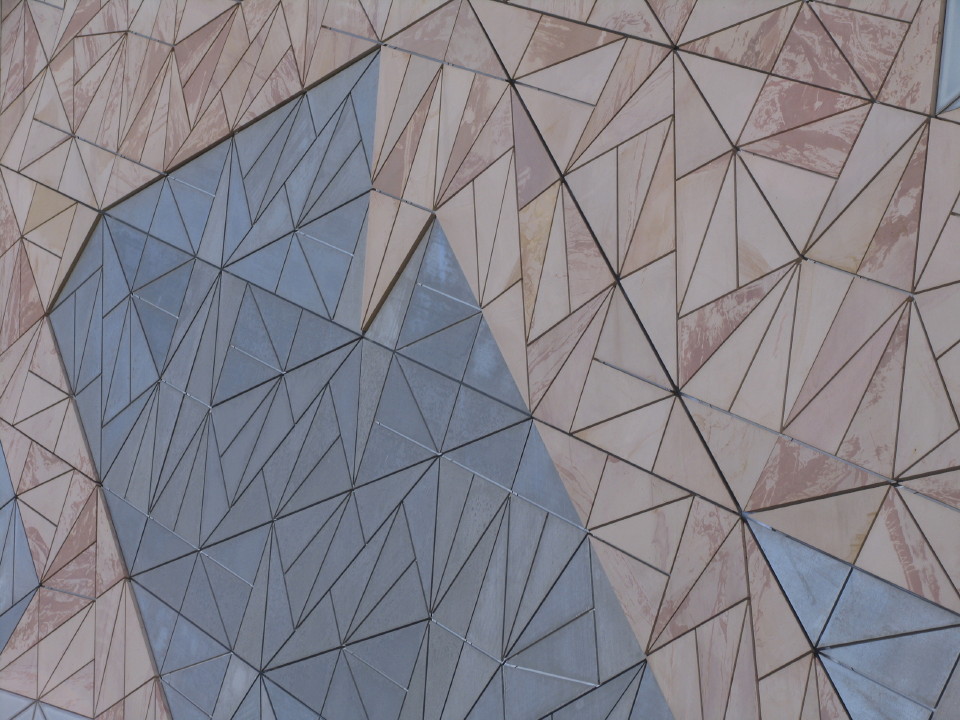
Facilities and tenants
In addition to a number of shops, bars, cafés and restaurants, Federation Square’s cultural facilities include:
Melbourne Visitor Centre
The Melbourne Visitor Centre is located underground, with its entrance at the main corner shard directly opposite Flinders Street Station and St Pauls Cathedral and its exit at the opposite shard. The entrance and exit shards feature interactive news tickers in colour LEDs and small screens promoting current activities. The Visitor Centre was intended to replace a facility which was previously located at the turn of the 19th-century town hall administration buildings on Swanston Street.
The Edge
The Edge theatre is a 450-seat space designed to have views of the Yarra River and across to the spire of The Arts Centre. The theatre is lined in wood veneer in similar geometrical patterns to other interiors in the complex. The Edge was named “The BMW Edge” until May 2013, when a new sponsorship deal with Deakin University caused it to be renamed “The Deakin Edge”.
Zinc
Zinc is a function space underneath the gallery building, and opens onto the Yarra river bank. It was intended as an entirely commercial part of the development of Federation Square, and is used for wedding receptions, corporate events, launches, and the like.
National Gallery of Victoria
The Ian Potter Centre houses the Australian part of the art collection of the National Gallery of Victoria (NGV), and is located at Federation Square (international works are displayed at the NGV International on St Kilda Rd). There are over 20,000 Australian artworks, including paintings, sculpture, photography, fashion and textiles, and the collection is the oldest and most well known in the country.
Well-known works at the Ian Potter Centre include Frederick McCubbin’s Pioneers (1904) and Tom Roberts’ Shearing the Rams (1890). Also featured are works from Sidney Nolan, John Perceval, Margaret Preston and Fred Williams. Indigenous art includes works by William Barak and Emily Kngwarreye.
The National Gallery at Federation Square also features the NGV Kids Corner, which is an interactive education section aimed at small children and families, and the NGV Studio.
ACMI (Australian Centre for the Moving Image)
The Australian Centre for the Moving Image has two cinemas that are equipped to play every film, video and digital video format, with attention to high-quality acoustics. The screen gallery, built along the entire length of what was previously a train station platform, is a subterranean gallery for experimentation with the moving image. Video art, installations, interactives, sound art and net art are all regularly exhibited in this space. Additional venues within ACMI allow computer-based public education, and other interactive presentations.
In 2003, ACMI commissioned SelectParks to produce an interactive game-based, site-specific installation called AcmiPark, which replicates and abstracts the real-world architecture of Federation Square. It also houses highly innovative mechanisms for interactive, multi-player sound and musical composition.
Transport Hotel Bar
Transport hotel and bar is a three-level hotel complex adjacent to the southern shard on the south western corner of the square. It has a ground-floor public bar, restaurant and cocktail lounge on the rooftop.
SBS Television and Radio offices
Main article: Special Broadcasting Service
The Melbourne television and radio offices of the Special Broadcasting Service (SBS), one of Australia’s two publicly funded national broadcasters is in one of the office buildings along Flinders Street.
Melbourne Festival headquarters
Main article: Melbourne International Arts Festival
The headquarters of Melbourne Festival (formerly Melbourne International Arts Festival) are located on Level 2 of the Yarra Building.
Beer awards
Federation Square has recently become home to several beer award shows, and tastings, including the Australian International Beer Awards trade and public shows, as well as other similar events such as showcases of local and other Australian breweries. These events have been held in the square’s indoor outdoor area the Atrium and usually require an entry fee in exchange for a set number of tastings.
Past tenants
Past tenants have included:
“Champions” – The Australian Racing Museum & Hall of Fame
National Design Centre
設施和租戶
除了眾多商店,酒吧,咖啡館和餐館外,Federation Square的文化設施還包括:
墨爾本遊客中心
墨爾本遊客中心位於地下,其入口位於主角街區,正對著弗林德斯街火車站和聖保羅大教堂及其對面碎片出口。入口和出口碎片具有彩色LED和小屏幕的交互式新聞報導,促進當前活動。遊客中心的目的是取代之前位於斯旺斯頓街19世紀市政廳行政大樓轉彎處的設施。
邊緣
Edge劇院擁有450個座位的空間,可以欣賞到Yarra河和藝術中心尖頂的景色。劇院採用木質飾面襯裡,幾何圖案與復雜的其他內飾相似。 The Edge被命名為“The BMW Edge”直到2013年5月,當時與迪肯大學的新贊助協議使其更名為“迪肯邊緣”。
鋅
鋅是畫廊建築下方的一個功能空間,通向亞拉河岸。它旨在作為聯邦廣場發展的完全商業部分,並用於婚禮招待會,公司活動,發布會等。
維多利亞國家美術館
伊恩波特中心收藏了維多利亞國家美術館(NGV)藝術收藏品的澳大利亞部分,位於聯邦廣場(國際作品在聖基爾達路的NGV國際展覽中展出)。有超過20,000件澳大利亞藝術品,包括繪畫,雕塑,攝影,時裝和紡織品,該系列是該國最古老,最知名的系列。
伊恩波特中心的著名作品包括弗雷德里克麥卡賓的先鋒(1904年)和湯姆羅伯茨的剪羊毛公羊(1890年)。同時展出的還有西德尼諾蘭,約翰佩爾塞瓦爾,瑪格麗特普雷斯頓和弗雷德威廉姆斯的作品。土著藝術包括William Barak和Emily Kngwarreye的作品。
聯邦廣場國家美術館還設有NGV兒童角,這是一個針對小孩和家庭的互動教育部分,以及NGV工作室。
ACMI(澳大利亞移動影像中心)
澳大利亞移動影像中心有兩個電影院,可以播放每部電影,視頻和數字視頻格式,並註重高品質的聲學效果。屏幕畫廊沿著以前的火車站平台的整個長度構建,是用於實驗運動圖像的地下畫廊。視頻藝術,裝置,互動,聲音藝術和網絡藝術都經常在這個空間展出。 ACMI內的其他場所允許基於計算機的公共教育和其他互動演示。
2003年,ACMI委託SelectParks開發一個名為AcmiPark的基於互動遊戲的特定於站點的安裝,該安裝複製並抽像出聯邦廣場的真實架構。它還包含高度創新的機制,用於交互式,多玩家聲音和音樂創作。
交通酒店酒吧
交通酒店和酒吧是一個三層的酒店大樓,毗鄰廣場西南角的南部碎片。屋頂設有一間公共酒吧,餐廳和雞尾酒休息室。
SBS電視台和電台辦公室
主要文章:特別廣播服務
澳大利亞兩家公共資助的國家廣播公司之一的特別廣播服務公司(SBS)的墨爾本電視和廣播辦公室位於弗林德斯街沿線的辦公樓之一。
墨爾本節日總部
主要文章:墨爾本國際藝術節
墨爾本藝術節(原墨爾本國際藝術節)總部位於亞拉大廈2層。
啤酒獎
聯邦廣場最近成為幾個啤酒頒獎典禮和品酒會的舉辦地,包括澳大利亞國際啤酒獎貿易和公共展覽,以及其他類似活動,如當地和其他澳大利亞啤酒廠的陳列櫃。這些活動已經在廣場的室內室外區Atrium舉行,通常需要入場費以換取一定數量的品嚐。
過去的租戶
過去的租戶包括:
“冠軍” – 澳大利亞賽馬博物館和名人堂
國家設計中心

FROM:https://en.wikipedia.org/wiki/Federation_Square
FROM:What is Federation Square?
Don’t you think it’s addictive?
Want to know more about the beauty of architecture?
Come and join our members to explore the beauty of architectural design.
覺得看得不過癮嗎?
想要知道更多建築之美嗎?
快來加入我們的會員,一同探索建築設計之美。
The above article is purely for appreciation and sharing purposes, as well as the construction of new technology and the public can be in-depth understanding of the information at the same time there are sources, will be able to query, no use of the document as a commercial transaction, if illegal, please inform the We will immediately remove the site, thank you for cooperation.
以上文章純粹作為欣賞及分享用途,以及將建築新型技術傳遞給與大眾能夠深入了解,同時資料還有來源,將可查詢,絕無使用該文件資料作為商業交易行為,如有違法請務必告知該網站我們將立即處理撤除,謝謝合作。

